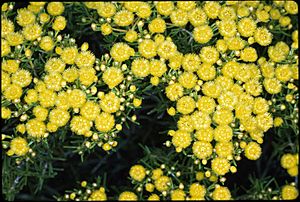Verticordia lindleyi facts for kids
Quick facts for kids Verticordia lindleyi |
|
|---|---|
 |
|
| Scientific classification | |
| Genus: |
Verticordia
|
| Species: |
lindleyi
|
Verticordia lindleyi is a beautiful flowering plant that belongs to the myrtle family, called Myrtaceae. This plant is special because it only grows naturally in the south-west part of Western Australia. It can be a bushy plant with many branches or a more compact shrub. It has small leaves and pretty pink or purple flowers. These flowers grow in spike-like groups along its stems. You can usually see them blooming in summer, and sometimes even in autumn.
Contents
About the Lindley's Featherflower Plant
Verticordia lindleyi is a shrub that can grow up to 1 m (3 ft) tall. It usually has one main stem. The plant can have branches that spread out widely or grow very close together.
Leaves and Flowers of Verticordia lindleyi
The leaves of this plant are shaped like an egg or an oval. They are slightly curved like a dish. Each leaf is about 1.5–5 mm (0.06–0.2 in) long. They are covered with short, soft hairs.
The flowers have a light scent. They grow in groups along the stems, looking a bit like spikes. Each flower sits on a stalk that is 1–4 mm (0.04–0.2 in) long. The part of the flower that holds the petals and sepals, called the floral cup, is shaped like a top. It is about 2 mm (0.08 in) long and has 5 ridges. This cup is smooth and has small, rounded green parts about 1 mm (0.04 in) long.
The sepals are usually pink or purple, but sometimes they can be white. They are 3–6 mm (0.1–0.2 in) long and have 5 to 7 hairy sections. The petals are the same color as the sepals. They are egg-shaped and measure 2.5–4.5 mm (0.1–0.2 in) long. Sometimes, they have a few tiny teeth at their tips. The style, which is part of the flower's reproductive system, is 3–4 mm (0.1–0.2 in) long. It is S-shaped and covered in hairs. This plant usually blooms from November to February. Sometimes, it can even flower as late as May.
How the Plant Got Its Name
The plant Verticordia lindleyi was first officially described in 1841. A scientist named Johannes Schauer gave it its formal name. He studied a plant sample collected by James Drummond near the Swan River. The description was then published in a book called Monographia Myrtacearum Xerocarpicarum.
The second part of the plant's name, lindleyi, was chosen to honor another botanist. This botanist was named John Lindley.
Different Types of Lindley's Featherflower
In 1991, a botanist named Alex George studied the Verticordia group of plants. He found that Verticordia lindleyi actually has two slightly different types, which he called subspecies:
- Verticordia lindleyi subsp. lindleyi has petals that get narrower towards their end. These petals either have no teeth or very small teeth at their tips.
- Verticordia lindleyi subsp purpurea has petals that are wider at their tips. These petals have larger teeth compared to the other subspecies.
Where Lindley's Featherflower Grows
This type of verticordia plant likes to grow in sandy soil. Often, this soil is found over clay or gravel. It prefers areas that get wet during the winter months. You might find it in open woodlands or areas with many shrubs.
It grows in a wide area of Western Australia. This includes places from near Mogumber, which is north of Perth, all the way south and east to the Stirling Range National Park. It is found in several different natural areas, including the Avon Wheatbelt, Geraldton Sandplains, Jarrah Forest, Swan Coastal Plain, Esperance Plains, and Mallee regions.
Protecting the Lindley's Featherflower
The Western Australian Government's Department of Parks and Wildlife keeps track of plants. They have classified subspecies lindleyi as "Priority Four". This means it is rare or could become threatened in the future. However, subspecies purpurea is currently considered "Not Threatened," which is good news!
Growing Lindley's Featherflower in Gardens
Both types of Verticordia lindleyi are popular plants for gardens. They grow well in soil that drains water easily and in sunny spots. Once they are established, they become strong shrubs. They can handle both dry weather and cold frosts. They are also good at resisting plant diseases caused by fungi.
Gardeners have been able to grow these plants in two ways. They can grow them from cuttings, which are small pieces of the plant. They can also grow them from seeds. A special project by the Western Australian Botanic Gardens and Parks Authority has had success. They moved different copies of V. lindleyi subsp. lindleyi plants to a new wetland area built at Perth Airport.

